
 |
Nyohoji is famous for its many old monuments kept in the temple. Kasa-ishi touba, capstone pagoda and Ita-ishi touba, Flagstone Pagoda were recognized as being the oldest memorial pagodas in the Tohoku area. They have been designated as important cultural assets by the national government. A copper bell without knot in the temple has also been designated as an important national cultural asset. Many people visit this temple for "Nanoka-Do Mairi, Worshipping at Nanoka-Do" from the night of January 6 to 7 from inside and outside Koriyama. ●15 minute walk from Koriyama Station (Reference) Koriyama City Board of Education, Cultural Division? Tel: 024-924-2661 |
 |
Here and there in the grounds of the Kashima Shrine are outcroppings of white pegmatite. It has been designated by the national government to be an important natural monument. It is estimated that there are more than 14,000 tons of the rock in the shrine compounds.? ●10 minute drive from Koriyama Higashi I.C (Reference) Kashima Dai Jingu Tel: 024-971-3276? |
 |
Nakaji no Daibutsu has the highest sitting height of 3 m in Tohoku area, being placed at Tokoji Temple. This is Take Roku Amidabutsu made by marquetry and finished by lacquer foil. It is said that Yoshiie Minamoto built Ichiu no Do to worship this Daibutsu in a mountain on 30 cho eastward of Nakachi Village when he was returning in triumph by the protection of God in Sanmori Pass. Later, when a fire broke out, the shoulders were undercut to pull Daibutsu out of Shrine. It is now placed on a wooden car to prevent the fire damage. Advance reservation is required for observation.? ●30 minute drive from Koriyama Minami I.C. (Reference) Senjuin Tel: 024-983-2723 |
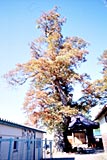 |
A prefecture-designated zelkova stands in the ground of Tokoji Temple where Nakaji no Daibutsu is situated. This is at the southern front of Tokoji Temple, showing the thickest figure in Koriyama City with 22m in height and 280cm in the diameter of the breast height. Zelkova is a prefectural tree of Fukushima Prefecture, and it can be seen in many parts of Fukushima. This zelkova of Daibutsu is referred to be the second largest tree next to Zelkova of Takase (Nationally designated) in Aizu Wakamatsu City. ●30 minute drive from Koriyama Minami I.C. (Reference) Senjuin Tel: 024-983-2723 |
 |
The ground of this shrine is full of natural woods, and many march-plants are bunched together among the mountain woods and the marsh woods. For hundreds of years, no sickle was used in the sacred area of 12 ha, so this has been kept to be a primary forest with a decaying condition of fallen trees though it is a small size.? ●50 minute drive from Koriyama Minami I.C. (Reference) Konan Office Tel:024-983-2117 |
 |
When you walk up about 8 kilometers from Akatsu of Konan Town to Mt. Aizu Nunobiki, you will see a Katsura tree standing with a lot of branches in closeness. This tree is with great force, and its estimated age is more than 350 years. It is unusually big as a Katsura tree and designated as natural monument by nation. ●50 minute drive from Koriyama Minami I.C. (Reference) Konan Office Tel: 024-983-2117 |
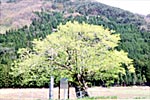 |
This Mayumi is a female plant and a gigantic tree that is 6m in height of 6m, 100cm in the diameter of chest height and 12m-square in the width of tree, showing the figure of umbrella. Since this has been long preserved as an independent tree in a farm, it is referred that it could live long as the best-balanced renowned tree. Its estimated tree life is over 300 years of age, and it is botanically very rare and highly valuable. ●25 minute drive from Koriyama Minami I.C. (Reference) Konan Office Tel:024-983-2117 |
 |
It is said that in the 4th year of Kangen (9th Century), the Bhuddist priest Kobodaishi carved a spiritual tree into a Senju Kannon in order to save people from disease and hunger. Although the simplified carving on the back showed that it was made in rural district, this is highly valued for its Kamakura period-specified features. You will see a colorful Tanemaki (seeds sowing) Cherry Tree and the couple of fir trees in Senjuin where Senju-Kannon is being worshipped. ●40 minute drive from Koriyama Minami I.C (Reference) Senjuin Tel:024-983-2723 |
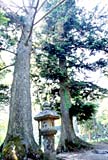 |
On the both sides of steppingstones extended to Kannon Do of Senjuin, two big fir trees stand face to face. The one on the right side of the steppingstones was broken in the middle due to the lighting stoke in the summer of 1990, yet it is 20m in height and 185cm in the diameter of breast height with a healthy condition. The fir tree on the left side is 40m in height and 130cm in the diameter of breast height, showing the vigorous tree force as well as the right one. The estimated age is 400 years old, presenting the largest figure in Koriyama City. It is highly valued as a giant tree in rural districts.? ●40 minute drive from Koriyama Minami I.C. (Reference) Senjuin Tel: 024-983-2723 |
 |
This temple is dedicated to the Buddhist master Shotoku Taishi. The six-storied stone pagoda, which was built during the middle of Kamakura Period, is very valuable. 10 old pagodas for memorial service stand near the shrine, and 7 pagodas among them were designated as city cultural assets. On the day of temple festival for Taishi (June 27 by the old calendar), three children offer three-lion-dance to the temple. ●20 minute drive from Koriyama Station (Reference) Koriyama City Board of Education Cultural Division? Tel:024-924-2661? |
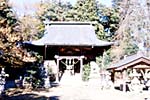 |
This shrine was constructed in Moriyama Block in Tamura Town along the Route 49 during Daido years. People offered Jushi or a miniature shrine designated as a prefectural important cultural asset and Dai Ema (a wooden tablet containing a picture of a horse and usually a prayer or wish, offered to shrines) from Torii school to this shrine. They say that Jushi was made in Azuch Momoyama period based on the whole style. In spring, the brightness of cherry blossoms is added to the sacred space, creating more impressive features.? ●20 minute drive from Koriyama Station (Reference) Tamura Shrine Tel: 024-955-2630 |
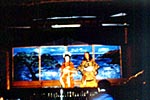 |
Yanagibashi used to be the land of Tokugawa Shogun in Edo period, so people could freely enjoy performance art. Kabuki started from the festival of Sugafune Shrine at which villagers enjoyed plays and songs. This was suspended by the strict regulation of play performance in Meiji period, but restored by the support from Yanagibashi Block in 1980. 15 titles including Ichinosawa Futaba Gunki (a military epic) are performed here. In the September fifteen .day's, Kabuki is performed on the stage of Kuroishi So as an autumn feature of Koriyama. ●30 minute drive from Koriyama Higashi I.C (Reference) Nakata Public Hall Tel:024-973-2951 |
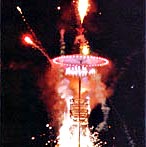 |
This is one of the set fireworks performed at the festival of the tutelary Kamegomori Shrine on the second Sunday of October. In oral tradition, this firework began from the beginning of Meiji period to pray for rain and ample harvest and to wish for the safety of their family. The closed umbrella is installed on the square frame of oil lump in a paper box. When the frame of andon is lighted by the fuse wire, the firework fly in all the directions, then the fuse wire lights Karakasa above and opens it. Finally, the lights shower to the ground.? ●20 minute drive from Koriyama Minami I.C (Reference) Mihota Public Hall Tel: 024-953-2819 |